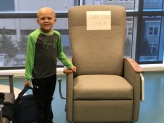Predictive Modeling of MDS Disease Progression From Inherited Bone Marrow Failure Syndrome Using Novel Branching Process and Next Generation Sequencing to Improve Patient-Specific Survival
Background
We are learning that an increasing number of pediatric cancers, especially leukemias, have a genetic predisposition. Wouldn't it be great to be able to prevent these life-threatening complications?
Project Goal
We propose to study a mouse strain at the point leukemia emerges from a pre-leukemic state. We will obtain serial snapshots of the genetic changes and use that information to build a predictive computer program. The goal will be to apply this computer program to children with leukemia predisposition syndromes. By tracking the disease with exquisite sensitivity, we want to predict before leukemia arises. In that situation, a stem cell transplantation will be needed. This timely intervention will improve survival for these children. This will also reassure other parents that their child is not at risk.
Project Update - June 2020
The inherited bone marrow failure syndromes (IBMFS) are cancer predisposition syndromes for the pediatric population. Fanconi anemia, Shwachman-Diamond syndrome, severe congenital neutropenia, dyskeratosis congenita, GATA2 deficiency, and Diamond-Blackfan anemia have 500-10,000x risk for developing myelodysplastic syndrome or acute myeloid leukemia (MDS/AML). Once MDS/AML arises, these blood cancers are resistant to chemotherapy and stem cell transplantation carries additional complications. One important goal is to determine which of the vulnerable children with these disorders are at greatest risk for MDS/AML and to intervene before the blood cancers emerge. We want to apply precision medicine (gene sequencing of new mutations) and plug into a computer program to predict the time course of the bone marrow disease and when it will evolve to MDS/AML. Since these disorders are uncommon and because the time to evolve to MDS/AML can be years away, we must use a mouse model to follow disease, perform the sequencing, and then develop the software. To do this, we will use a mouse model that follows the course of anemia->MDS->AML. The mouse model will take about 2 years to follow. Presently, we are breeding the mice. Meanwhile, we are developing computer software and acquiring information about mutation frequencies. With support from the Alex's Lemonade Stand Foundation award, we have also learned that mutations may not occur with more frequency in an inherited bone marrow failure syndrome. Two manuscripts have been submitted: one on the acquisition of new mutations associated with MDS/AML and another on computing the relapse of AML based on measurable residual disease. Another manuscript is being written on mutation rates.

